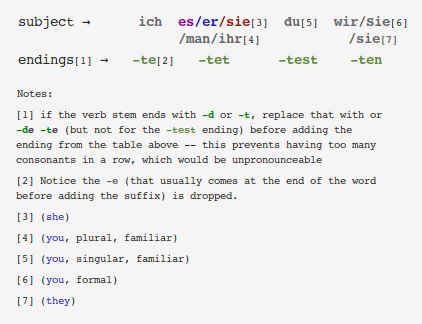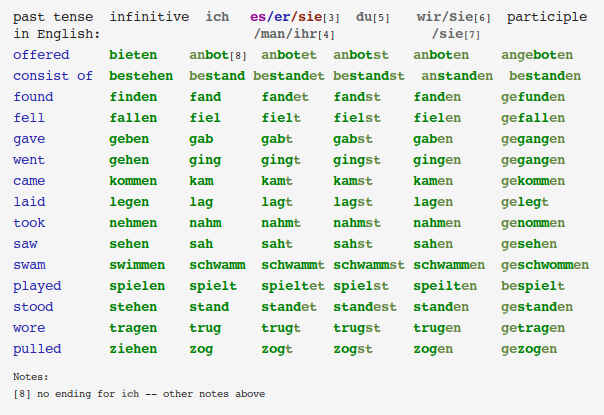So far, Jennie’s German Language Classroom for English Speakers has only discussed verbs in the present tense. This article introduces the Vergangenheit or past tenses.
Multiple kinds of past tense
There are three kinds of past tense in German. In efficient German style, they are often numbered:
1. Vergangenheit — Preterite (Präteritum), or simple past tense
This tense is used for actions that were started and completed at a specific time in the past. For example, I went food shopping yesterday. It can also be used for repeated actions, like I took 6 air trips last year.
2. Vergangenheit — Perfect (Perfekt) tense
Use this for actions that have happened in the past, that aren’t complete or completable and/or have occured over an indefinite period of time. I’ve been watching a lot of TV lately is in the perfect tense, because watching TV is not something you actually finish, and because lately is not a specific point in the past. In English, there is usually some form of have before the main verb.
German grammar makes a sharp distinction between the preterite and perfect tenses, although English grammar doesn’t.
3. Vergangenheit — Pluperfect (Plusquamperfekt), or past perfect tense
This is useful for actions that were completed before some other point in the past. Like I had left in time to catch the train (catching the train was in the past, and leaving in time was before that). English often has some form of had before the main verb.
If you’re still not sure of which past tense to use, keep in mind that the simple past tends to be preferred for mass communications, such as the news, official notices (such as letters from the Motor Vehicles Bureau), and by northern Germans; while personal conversations and southern Germans lean towards the perfect tense.
The simple past tense
This is grammatically similar to the present tense — the word order is unmodified, and a change to the verb itself is what makes it the simple past. Often the change is just by adding a -te to the end of the word, according to the following endings:

Here are some examples of this, along with their participles, which are useful later on:

There are a number of verbs that, rather than adding the letters -te to form the simple past tense, change the verb stem instead. This is completely separate from any present-tense verb stem changes that may occur. There is no easy or simple rule to know when this needs to be done, except that many verbs that do this are old words, those that have existed for hundreds of years. Here are some of the more common ones:

Finally, a few verbs change their stem and take -te endings. Here are two examples:

2. Vergangenheit — perfect tense
This can be recognized by the use of the participle, which usually (but not always) has a ge- near the front of the word.
When constructing a sentence using the 2. Vergangenheit, start by putting the main verb where the main verb usually goes. Change that to a participle, then put the correct auxiliary (haben or sein) after it. (A third choice is the verb werden, but that is not as often used. It is not further discussed here.) Now move the participle to the “back porch” (usually the end) of the sentence, and conjugate the auxiliary (haben or sein) to match the subject. (The main verb is made into a participle but is otherwise not conjugated.) So I have washed becomes Ich habe gewaschen.
Which auxiliary to use?
Of the two main choices, haben (conjugated), or sein (conjugated), only one is correct in any given situation. A quick rule of thumb is to use sein if you “use your legs” while doing the action.
But the real rule is to use haben with transitive verbs, and sein with intransitive ones. Transitive verbs describe doing something to something, such as painted the wall, while intransitive verbs are for those actions that never have objects, like think (you can think of something, but you can’t put think onto something).
If you have a transitive verb for which you leave out the object, that doesn’t make it intransitive. For example, I ate lunch has an object of lunch (it was the lunch that was eaten) but I ate doesn’t mean there is no object — the object was simply not stated. So use haben, as in Ich habe gegesen.
But haben (have) and sein (be) as main verbs always take themselves as auxiliaries. (The participles are gehabt and gewesen respectively, but they are not used that much. Better to use the simple past tense for haben and sein, even if the rest of what you’re writing is in the perfect tense.)
3. Vergangenheit — plusquamperfect or past perfect tense
The rules for constructing a sentence with the plusquamperfect tense are the same as for the perfect tense, but when conjugating haben or sein, use the simple past tense forms instead of the present tense forms. So you can say ich hatte mich gewaschen, which means I had washed (myself).
Modal, triple verb, and passive sentences
These are further discussed in the lessons about modal and passive voice sentences (to be published), but a few points are worth discussing here:
Modal verbs are used to modify the meaning of the “main” verb in the sentence. For example, können means (be able to), so schrieben können means be able to write (where schreiben [write] is the main verb). When constructing a sentence using a modal verb, move the main verb to the “back porch” and conjugate the modal. So You can write the letter becomes Du kannst den Brief schreiben.
The triple-verb structure
So why is this being included in a lesson about past tense? Because in the perfect and past perfect tenses, an auxiliary verb is added, and now we have a triple-verb sentence. The three verbs here are schreiben (main), können (modal), and haben (auxiliary). It helps if you think of them in that order when beginning the task of constructing a triple-verb sentence.
Consider the following unfinished sentence, with infinitives used (for now) for all three verbs):
![]()
Now take the first verb schreiben and move it around to the back.

Now take the next verb, können, and move it to the back too (both these verbs will remain unconjugated).

Note the verbs schreiben and können are in the same relative order as when you started.
Finally, conjugate the auxiliary verb.

This form of sentence is known as the double-infinitive form.
Passive voice
The only thing I want to say about the passive voice — saying something was done but not saying by whom — at this time is you always use sein as the auxiliary verb.
Look for Jennie’s German Language Classroom for English Speakers on a Wednesday near the end of the month.
Copyright © 2020 by Jennifer Freeman. In particular, permission is not granted to assemble the parts of this series together and distribute them. You may of course post links to the individual posts.